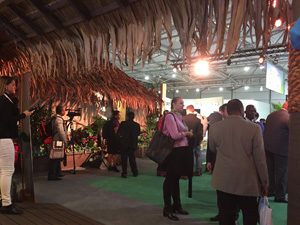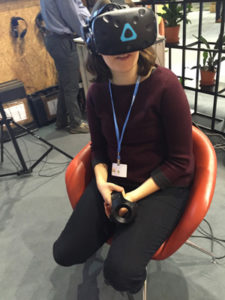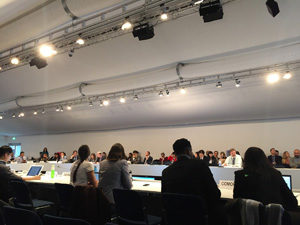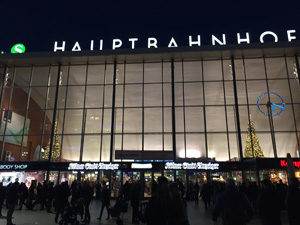UN Climate Change Conference in Bonn, Germany
Contact
Environmental StudiesOlin-Rice Science Center, Room 249 651-696-6274
esson@macalester.edu
instagram twitter
Prof. Roopali Phadke, Ellen Janda ’19, Kathryn Lund ’18, Ariana Lutze-Jahiel ’17, Julia Makayova ’18, and Mariah Shriner ’18 attended the UN Climate Change Conference in Bonn, Germany, from November 6 – 17, 2017. This 23rd session of the Conference of the Parties (COP 23) brought together delegates from nations all over the world to continue their work on strengthening our global response to climate change.
Related articles:
- “Rising Greenhouse Gas Emissions in 2017 Surprise Some”, MPR News, Nov. 16, 2017
- “Minnesotans in Bonn Say Climate Progress is Up to States”, Public News Service, Nov. 20, 2017
Students’ Daily Blog
Day 1: Monday, November 6, 2017
This morning, we rode the train in from Cologne to the Bonn UN campus. On our way we met a woman, Monique, from the Cameroon delegation. We walked with her from the train stop to the Bula campus, which is the diplomatic zone. The opening plenary began as the COP22 President from Marrakesh, H.E. Salaheddine Mezouar, welcomed us to Bonn. He spoke about the importance of cooperation, solidarity amongst developing nations, and a growing tradition of non-state actor participation. All seemed like viable strategy for combating the lack of leadership by the United States in global climate solutions. He then invited Frank Bainimarama, Prime Minister of Fiji, to officially accept the Presidency of COP23. As the first Pacific Island nation to host a COP, the Fijian presidency is especially notable as many of these countries are already facing the severe effects of climate change. Following his speech, a group of Fijian men performed a ceremony that included traditional song, dance, and clothing to celebrate and welcome the transition and the opening of the conference. A number of other leaders from the COP community also spoke, including Barbara Henricks of Germany. One of the main messages that we took away from this plenary was the importance of action and the implementation of the Paris Accord.
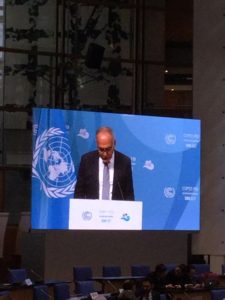
Following the plenary, we headed over to the Bonn Zone, which is to be used by both state and nonstate participants. There we each ate our own sustainable, locally sourced lunch from the cafeteria and broke apart to attend different sessions.
Ari:
I attended a panel session entitled, “Peasant Agroecology Feeds the People and Cools the Planet,” which was sponsored by two grassroots organizations: La Via Campesina (LVC), Secours Catholique-Caritas France (SCCF). The panel began by discussing the fact that 50% of GHG emissions can be attributed to the industrial food system, which suggests that there is much work to be done in this complex sector. The four panelists, who were peasants from Puerto Rico, Indonesia, France, and Mali all argued that a food system based on peasant agroecology and food sovereignted will help cool the planet. In addition, they all agreed that the current industrial food system has been colonialist, corrupt, and militarized. The root of the climate injustices faced by these peasants is a result of US and European consumption and capitalism. Agroecology, on the other hand, is a social movement based on traditional knowledge with the aims to empower farmers and fishers as well as aid in creating climate justice for communities impacted by these Big Ag corporations.
The panelists said that while these conversations are happening in local communities around the world, it is of the utmost importance that they are also happening in these types of international settings, particularly in the UN. But the panelists also had harsh criticisms of international decision making, stating that the Paris Climate Agreement relies on the commodification of nature and is ultimately non-binding. Overall, I found this panel absolutely fascinating. It was amazing to see grassroots organizers on an international platform, speaking with such passion. In addition, I was surprised that there was such strong criticism of the Paris accords in a UN sponsored event, but also found this reassuring as it shows that the UNFCC is really trying to bring in different voices and perspectives on climate change. And now, I find myself extremely interested in learning more about agroecology.
Ellie and Ari:
We attended a panel by the Global Ecovillage Network (GEN), which is a world network of communities looking to build intentional, sustainable lifestyles. The speakers represented each region of the world, and described the various ways ecovillages address a diverse range of local issues. One aspect we found particularly interesting was the potential to rebuild areas destroyed by climate crises using this sustainable model. One of the panelists said that if just 5% of Europeans lived an ecovillage lifestyle, Europe would meet 80% of its Paris 2020 goals. This is quite a notable statistic, and we are both curious to learn more about ecovillages, particularly those in the US. In closing, the panelists also stressed that they are trying to bridge ecovillages with urban areas, which would make them more accessible. This is also relevant in the context of the US, and we are interested in learning progress in creating urban ecovillages in the US. https://ecovillage.org/
Ellie:
The second session I attended was titled The Role of Women as Guardians of the Ocean, and was sponsored by WWF. A panel made mostly of leading women from Fiji spoke to the importance of gender equality during the development of climate protection strategies. Within the Fijian island communities, women often occupy the base of traditional knowledge and cultural education. The personal narratives shared also spoke to the urgency that the Pacific islanders feel over the issue of climate change, for while technology may mitigate rising sea levels, development cannot fix the loss of a home.
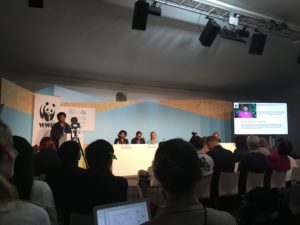
Mariah:
The first session I attended was put on by the Climate Action Network (a network of over 850 environmental NGOs) entitled “Yardsticks for Success at COP23” to get an overview about some of the things to be aware of in the negotiations that will happen for the next two weeks. Speakers from a number of countries including NGO leaders from France & Fiji and Ambassadors from Fiji & Morocco spoke, each bringing their own perspectives to the issues at hand. As this is the second COP since the Paris Climate Agreement, there was continued emphasis on how creating specific goals and setting plans into motion before upcoming reviews (like the five-year Global Stocktake in 2023). Equally emphasized were the importance of finances, support for communities already facing the effects of climate change, and continued recognition of non-state actors as key players in the conversation:
- Financial matters, including:
- Clear financial support from developed countries (for their commitment of $100 billion)
- Transparency in accounting
- Support for frontline communities, including through:
- Enhanced climate adaptation (the Adaptation Fund — ensure financial sustainability and articulate its functions)
- Loss & Damage
- Non-state actors:
- Empower the most marginalized by adopting a gender action plan and elevating indigenous voices
- Workshops between party and non-party actors
- Public participation in the decision making
The second session I attended was titled “Imagine our world with +4 degrees celsius: Coping with the impacts of climate change on freshwater, oceans and cities.” The Paris Climate Agreement set forth a goal of no more than a 1.5 (or maximum 2) degree celsius increase over global pre-industrial levels. However, our current track puts us much closer to a 4 degree increase and this talk provided a number of different perspectives of how this will play out, focusing on water systems around the world. It is definitely a sobering topic and one of the key messages I took away from this talk was just how interconnected all of these issues are. A representative from the Nordic Cooperation (Denmark, Norway, Sweden, Iceland, and Finland) pointed out how, while all five countries are doing well on reaching the Sustainable Development Goal #6 (Clean Water & Sanitation), they need to also take into consideration how other aspects like consumption and production are linked. Another panel speaker, focusing on the case study of the Mediterranean, noted that high temperatures mean not only sea level rise, heat waves, and extreme weather events (devastating in and of itself), but also will lead to more fires, changing ecosystems, loss of soil, and decreased agricultural yields (and more).
We closed out our day at the Evening Reception, which included delicious snacks, drinks, and lively performances from the Fijian Police Band. Recognizing a “No DAPL” t-shirt, we approached the man (Michel) wearing it and asked him whether or not he was from the upper midwest. Although Michel wasn’t (he was from Ecuador), we engaged in a lively conversation about indigenous rights. We spent most of the evening talking with Michel as well as a number of individuals from a broad coalition of indigenous peoples (including Brazil, Guatemala, and Indonesia). Each of them are active in their own fights and community groups, but they are spending four weeks touring five cities in Europe through the Weaving Ties Initiative (weavingties.org).
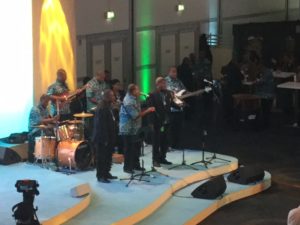
Day 2: Tuesday, November 7, 2017
Mariah and Ari:
We started our day by attending a press conference by Climate Action Network International in the Bula Zone. While there were three panelists, the press found the speaker from China most interesting and asked him most of the questions. This speaker opened by explaining that Trump’s presidency and the US pulling out from the Paris Agreement was an opportunity for China as it allows China to take on a leadership role in regards to action on climate change. The speaker said that China was already doing this—China has begun to phase out coal fired power plants and has increased its participation in climate diplomacy. He also raised the point that China does have continued room for improvement with regards to reporting on their progress, needing more frequent, higher quality, and broader coverage. Additionally, many of the same yardsticks of success from yesterday’s talk were repeated as things to keep an eye on throughout these two weeks.
Following this press conference, we headed over to the Bonn Zone, taking a solar-powered zero-carbon emission trolley to get there!
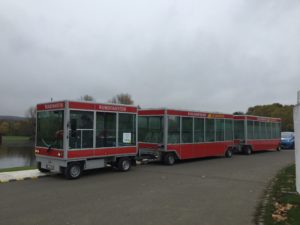
Another transportation option between the two zones are free bike rentals:
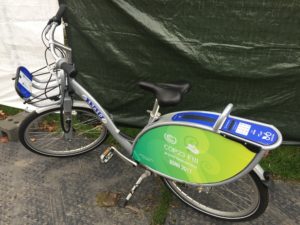
Mariah:
My next event of the day focused on climate change for Caribbean UKOTs (UK Overseas Territories), and was officially titled “Trouble in Paradise: Reducing vulnerability and enhancing island resilience to climate change in the Caribbean.” In the initial plan, representatives from the Caribbean and other small island (SIDS – Small Island Developing States) parties were supposed to lead the discussion but due to a scheduling mix up, many of them were attending other SIDS meetings. Instead, a man from the Royal Society for the Protection of Birds (RSPB) lead the conversation, providing an interesting ecological perspective. The talk touched on impacts that are already occurring as stronger storms become the new norm and about the projected physical impacts, which include a decrease in precipitation (5% by 2100), sea level rise (0.5-0.6m by 2100 in the Caribbean sea), and ocean acidification. A representative from the Fijian party spoke up from the audience at the end, sharing her experiences in an environmental NGO in Fiji and Fiji’s current progress in recovering from Cyclone Winston (2016 – Category 5, most intense on record in the Southern Hemisphere and strongest to make landfall). Discussions of resilience included mentions of the differences between soft and hard engineering, as well as concerns that there may not be enough time or data to build the needed resilience when it comes to protecting ecosystems and many endemic island species.
Later in the afternoon, I attended a second session, “Coordinated Action on Sustainable Development.” I chose the talk partially because two individuals from Nepal were speaking on the panel (a representative from the government and one from ICIMOD (International Centre for Integrated Mountain Development)), but there were also representatives from IASS (Institute for Advanced Sustainability Studies), PaCE-SD (Pacific Centre for Environmental and Sustainable Development), and a country representative from the Solomon Islands. The talk itself was quite interesting and I feel like I got a well-rounded look at a number of different stakeholder perspectives of the intersection between climate change and sustainable development. One of the most thought-provoking components of the talk was simply the choice of countries (Nepal, Solomon Islands/the other Pacific islands) and its significance within broader contexts at the conference. While SIDS have their own regional designation at the conference, there was apparently a recent report that also linked these high mountain and island communities in conversations about climate change impacts. This may be done partially because both areas are already seeing the negative impacts of climate change on their communities in a more direct and significant way than some other regions, but the correlation may also erase some of their unique challenges and opportunities.
Ultimately the talk was very positive about the actions that are being taken at NGO, community, and governmental levels in the respective areas; I found this to be reassuring but I also know that there is so much that still needs to be done, in Nepal and around the world, and that I need to not be lulled into a false sense of security about the severity of these issues.
Ari:
At lunchtime, I met Bernard, one of the heads of sustainability for Porsche, Germany. He told me that this was not one of his first COPs by any means, and he was here as an observer and would be speaking on a panel later this week.
Following my conversation with Bernard, I headed to the German Pavilion for a talk on the role of cities in addressing climate change. The head of the German Advisory Council on Global Change (WBGU) said that cities are responsible for a large percent of CO2 emissions and if we want to decrease atmospheric CO2, we have to change our cities. She highlighted the fact that there are many sector specific solutions for climate change in cities, but there is no overall view, particularly in respect to urban local governance. For urban transformation, the head of WBGU said that we must sustain natural systems (keeping them in harmony both globally and locally), promote eigneart (which roughly translates to people-oriented, diversity of cities), and finally to ensure inclusion through making political participation and economics accessible to the citizens). In addition, we must enable city governments to decide their local affairs and establish collaborative governance structures across cities and countries.
After this session, I attended a panel on lands, oceans, and water-food-ecosystem resilience in the mid-latitude region. This talk involved discussions of traditional knowledge in agriculture, farmer-managed natural regeneration, and supporting indigenous voices both financially and otherwise. The final panelist said that the Paris Accord left indigenous people feeling furious. The loss and damage these people have incurred from natural disasters cannot always be monetarily quantified. Moreover, climate finance is not currently reaching those who are most vulnerable to climate change.
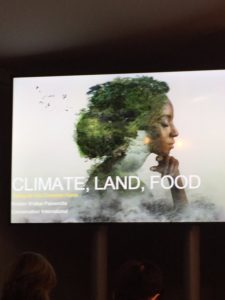
Thus far I have really noticed the intentional integration of indigenous voices at this conference, at least on the Bonn Zone side. However, it feels that there are two main categories of countries who have been participating on these panels and those are the most wealthy countries and the most destitute. There seems to be little space for those countries that fall into the middle sector of wealth, and I am eager to hear from them.
Ellie:
My first day at COP23 was filled mostly with sessions given by civil society actors in the Bonn Zone, however, I was interested to see if this group’s aspirations translated into the diplomatic process, and spent all of day two in the Bula Zone.
First I attended the third plenary session of the APA (Ad Hoc Working Group for the Paris Climate Agreement). The meeting opened with an opportunity for civil society leaders to voice their opinions on motions discussed during previous negotiation sessions. These leaders represent large umbrella coalitions, formed around issues such as women and gender, trade unions, and the private sector.
Then, I watched a press conference by WWF on the options for accelerating the Paris Initiatives during the COP23. It provided an update on various country positions, as well as important trends to watch for at this conference. One of the more interesting things discussed was the difficulty in fulfilling the funding goals necessary for implementation. A speaker on the panel said that the struggle to gather funding pledges from developed countries was beginning to erode the fragile trust between countries achieved in Paris.
I then sat at the Conference of the Parties (COP) Plenary. The meeting began with a word from the Palestine delegation. The speaker stated the importance of equal implementation of the Paris accords, which requires each country to follow through on their NDC’s. The COP president, Prime Minister Frank Bainimarama of Fiji, then guided the meeting through agenda items two and ten. Agenda item two was titled Organization of Work, and addressed the future leaders and hosts of COP conferences. Agenda item ten was titled Climate Finance, and featured reports given by both the Green Climate Fund and the Global Environment Facility. During both agenda tasks, brief statements were heard by country leaders and civil society. These positions will be further negotiated at smaller meetings.
Finally, the Conference of the Parties of the Paris Agreement (CMP) met for a plenary towards the end of the day. The agenda item being discussed addressed the structuring of dialogue during Fiji’s COP. Leaders from COP22 reported on the ways in which they integrated outside opinions during their COP, followed by a report on the current forums open for discussion at COP23. Speakers from both the Maldives and Iran stressed the need to have open and inclusive dialogue. The Iranian leader in particular spoke to the need for empathy and collective action while moving forward with Paris implementation.
We ended the day a little earlier than yesterday, returning to Cologne (Köln) with enough time to go out for dinner and walk around the cathedral!



Day 3: Wednesday, November 8, 2017
We all took an early train into Bonn this morning. We sat on the upper level where an older man, Muhamed, started up a conversation with us. Muhamed had come to Germany to go to school in his 20s, ended up staying, working as an electrician and marrying a German woman. He’s been here for over 40 years now and expressed how difficult it is identifying as neither fully Ethiopian or fully German — he’s not sure where to call home now and is seen an outsider in either place. He also told us how amazing he thought America was—the people are so nice, the houses so big, the cities so spread apart. His five sisters all live in America, and are very successful. He told us that in America, people can come from nothing and make it. Three of his sisters worked at 7-11s and were able to pay for college that way. We told him that it may have been that way 30 years ago, but things are pretty different now. He still seemed to have a romanticized view of it, though. He said that in Germany, Germans are nice to you if you’re American, but if you’re black or Arab, it’s different. He noted the increasing challenges more recently with the influx of refugees and that some Germans have a lot of resentment based on the idea that newcomers are taking all of their money and resources while they’re struggling too. It was a very interesting conversation, and definitely gave us a different perspective on diversity and inclusion in German society.
Ari and Mariah:
When we arrived at the Bula Zone, we headed to the RINGO (The Constituency of Research and Independent Non-governmental Organisations to the United Nations Framework Convention on Climate Change) meeting. Each morning, individuals associated with the group meetup to share their experiences in various official meetings the previous day (attendance is often limited), discuss what is on the agenda for the day, and go over any topics regarding the constituency as a whole. There, we were each able to get a pass to gain access to one of the APA (Ad Hoc Working Group on the Paris Agreement) negotiating meetings of the day.
We then attended the SBSTA informal consultations on local communities and indigenous peoples platform. The overall statements coming from various countries was that they needed more time to digest and analyze the text, that indigenous people should design the platform, and that the working group should have an equal representation of indigenous people and party members. There were over 15 parties represented, which is a small percentage of the overall number of parties but the co-chairs seemed quite satisfied with the turnout and remarked that the attendance was higher than their previous meeting on the subject.
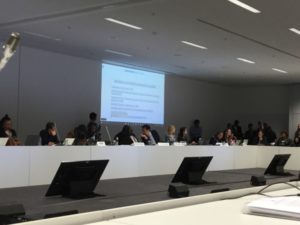
Ari:
I left the informal consultation a bit early in order to attend the meeting on APA Agenda Item 7. This session was highly bureaucratic. The discussion was mainly around whether or not Article 15 of Agenda Item 7 should be linked to the transparency article. For the first 45 minutes of the meeting, approximately seven countries talked, including New Zealand, the EU, Saint Kitts and Nevis, and Argentina. All the countries affirmed that the linkage between the two is very important. Then, Saudi Arabia, speaking on behalf of the Arab Group, said that it was far too premature to even discuss this issue and that the transparency framework cannot be linked right now as it could negatively impact the perceived independence of Art. 15. This session and the previous one definitely gave me a glimpse into international decision making, but they were a bit hard to follow and clearly not meant to be accessible to observers.
Following this event, I took the shuttle to the Bonn Zone where I attended an event in the German Pavilion entitled, “Decarbonization of Aviation.” The three panelists stressed that aviation is the fastest growing GHG emissions source and that we must begin implementing the use of renewables in this type of travel. The only source that the three panelists seemed to agree on was liquified gases. However, the largest prohibitor currently is the cost. The moderator asked an interesting question at the end that I want to share with you. “How does the efficiency of renewables compare to fossil fuels?” A panelist responded by saying that it is not a question of comparison, but rather a question of sustainability. Fossil fuels are not a sustainable source of energy, the other options might be, and we should at least begin pursuing them. I attended this talk because the largest part of my environmental footprint is absolutely related to flying. When it comes down to decreasing our aviation footprint, we have to be willing to change the market, and I am not sure that people are ready to do that. I am eager to see which one of the alternative fuel sources makes its way to the forefront of air fuel in the future, but only time will tell.
The final event I attended today was a talk on the Red Sea and Gulf of Aden. This talk was quite scientific, talking about the ecology of the region, how they collect data and monitor the habitats, and finally how to conserve and restore certain ecosystems. In many ways, I found this talk really positive. They focused on protection of biodiversity and benefits and co-benefits of adaptation in the area. They also explained that the Red Sea is home to coral reefs and that the waters in the Red Sea are warmer than most coral sea waters, and the CO2 levels are about the same in this area as they were under preindustrial conditions. The combination of these two facts mean that Red Sea coral reefs are not facing the same doom that many other coral face worldwide.
Mariah:
From the SBSTA meeting I headed to the Bonn zone to attend a talk titled “UN Climate Justice: Just Transition for all and a human rights-based approach to climate action,” which included speakers from the ILO (International Labor Organization), the Philippines, ITUC (International Trade Union Confederation), and NHRIs (National Human Rights Institutions). I’ve been thinking a lot about the importance of a just transition since watching From the Ashes and learning about the proposed Portland Just Energy Transition initiative (in Portland, OR), so I was glad to see so many people at this meeting. It was also super interesting to get the labor and trade perspective, especially since I usually hear their voices in on the opposing side of issues regarding fossil fuel infrastructure in the Pacific Northwest. The speaker from ILO spoke to this issue most and noted that quality and quantity of jobs could be affected both negatively and positively by the transition to climate action but that ultimately these questions depended on most on timeframe, implementation of social support, market conditions, and a number of factors. Overall there seemed to be a consensus that a just transition represented an opportunity to combine human rights, sustainable development goals, and effective climate action.
From there, I caught the last few minutes of questions at a panel on climate-related human mobility. It was super cool and included a lot of interesting points about questions on how to define what is climate-related movement and if that definition is critical to taking the needed action. One awesome thing about many of these side events is that the contact information of those leading them and the speakers are posted online – I’m excited to follow-up on the topic!
After a quick break to finalize my notes from my morning, I headed back out to the Bula zone again, this time for my APA meeting on Agenda item 8b — relating to implementation of the Paris Agreement (except the Adaptation Fund). Like Ari’s meeting earlier, I was struck by the contrast of the negotiations to the lively activities in the Bonn Zone – it was hard to tell if any progress was made on the issue during the hour-long meeting and it seemed so far removed from the discussions of actual climate action. The group was discussing Article 9, Paragraph 5 of the Paris Agreement, and most specifically their mandate under it. However most of the meeting was spent in repetitive debate about whether an earlier motion by China in a small group meeting had been accepted as an amendment or just proposed. I didn’t have much background information on the issue but it was fascinating to see how countries aligned themselves with each other, how the co-chair dealt with the conflict, and the nuances of procedure.
Ellie:
I spent my day on a UN excursion to view three facilities which sit at the forefront of green energy use in the region. Each was project was an innovation in its field, and had been carried out largely due to the ambition of highly driven individuals. The trip was coordinated by Energie Agentur, an organization which coordinates energy research and implementation for the German state of North Rhine-Westphalia.
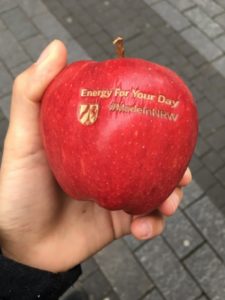
First, we went to the headquarters of the Deutsche Post DHL Group, a mail delivery company. Impressively, they are on track to achieving 70% emission-free delivery by 2025, and zero-emission delivery by 2050. In order to do this, the Group oversaw the design of two electric delivery vehicles, and three bike models (pictured below). These models are now available on the market, and have been sold to a variety of other European delivery companies. The DHL electric fleet is currently operating at the limits of the German electric grid. In order to maximize usage, the Group created a computer system to monitor grid capability and then direct vehicle charging needs accordingly. They have been active in advocating for increased electric infrastructure at the local and state level in North Rhine-Westphalia.
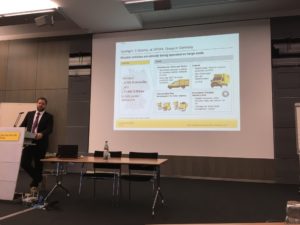
Next, our group traveled to the hotel, Kameha Grand. The hotel occupies a huge building complex which is heated and cooled through a geothermal system that stores energy in the natural aquifer below. During the summer this system provides 70% of the building’s cooling needs, while in the winter months it can cover up to 80%. The system is quite large, and regulates the temperature of three surrounding buildings as well. This results in an estimated offset of 400 tons of CO2.
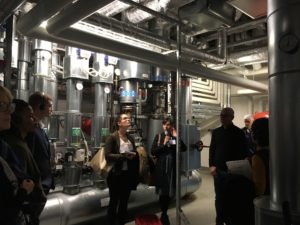
At our third stop, we met with Welthungerhilfe, an international development aid organization. Their facility is heated by the incineration of wood pellets, which are made from the sawdust waste of local forestry companies. This has allowed for a carbon offset of 368 tons of CO2 per year. The organization made the decision to install this system because they recognize the heightened impact of global climate change upon underdeveloped areas.
We ended our journey with a trip through the hills above the Rhine river. We took a railcar up Drachenfels mountain to view castle ruins which date back to the 1600’s, as well as some very impressive fog.
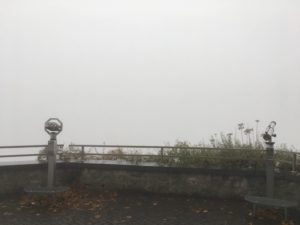
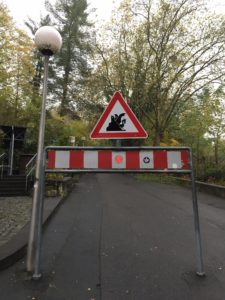

Day 4: Thursday, November 9, 2017
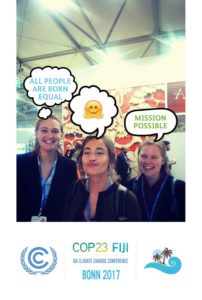
Ellie:
Ari and I spent the morning touring around Cologne’s city center before finally hopping on the train. We visited a bakery for breakfast and then walked through the Cologne Cathedral.
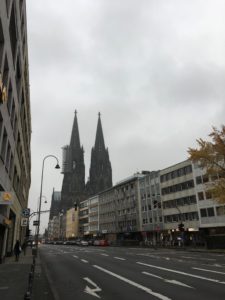

When we finally arrived at the conference there was some time to wander around the pavilion space. We took some pictures and drank good coffee at the Germany pavilion, and watched dancers at Fiji’s pavilion. In a far back corner of the space I found the Russian pavilion and began a very interesting conversation with one of the staff members. He congratulated the United States on finding a market solution to high carbon emissions through our increased natural gas usage. He says the Russians have been applying this value to their system of recycling. They have been able to greatly recycling of plastic and aluminum bottles by paying people to return them to recycling centers. While this system exists in the United States, it is far more effective in Russia, for he informed me that their European neighbors have begun to send bottles to their centers as well. All interesting facts that I will have to look into . . .
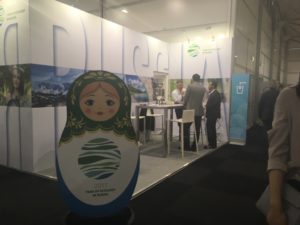
I then attended a talk held at the Indonesia pavilion titled Innovation in Mangrove Ecosystem Management to Support Community Livelihood and Climate Change Mitigation. This issue has been the focus of many studies done by the Center for International Agricultural Research. There is a really optimistic feeling in the region that mangrove trees can both mitigate the effects of rising sea levels and improve air quality. It is a tricky solution, however, as projects must be executed in areas that are compatible both socially and environmentally.
Next, I attended Nurturing Progress in Reducing Transnational Air Pollutants, held by the South Korean pavilion. The first speaker was involved in Korean foreign affairs, and adamantly stated that the solution to this issue relies on international cooperation. He was followed by Gerardo Sandez Martinez, a professor at DTU. Dr. Martinez stressed that climate change should have been viewed as a health concern from square one. Korea is an important illustration of this, for it experiences a high number of premature deaths due to air pollution. Health is high on the political agenda, and people tend to take it seriously. Most of the suggestions provided at this talk had to do with framing climate change as an issue relevant to the lives of all.
For my final event, I was back at the Indonesia pavillion for a talk about peatland restoration. The country has experienced a bilateral approach to peatland protection and monitoring. Both market interests in the private sector, as well as international NGO’s have taken an interest in this. There remains large needs, such as research into possible sustainable livelihoods within peatlands and further data collection into peatland mapping, however, this is another topic that the climate mitigation community is extremely excited about. I noticed, however, that there was very little government action involved in the monitoring and preservation of Indonesian peatlands. It is sad to see the production of such a large COP23 pavillion, with little action to back it up.
Ari:
I started the conference part of my day by attending a talk in the Cities and Regions Pavilion. The talk was centered around the connection between the Paris Agreement, national governments, and local governments. The panel included two Mayors, one from a town in Botswana and the other from a town in South Africa. In addition, there was a man who served in the national level government in Cote d’Ivoire. The mayors discussed the fact that nations present the Paris Agreement as a good framework, but it is most effectively actualized at the local scale. From here, the mayoral panelists talked about sustainable initiatives that they had implemented in their towns, including bettering rapid transit systems, creating infastructure to transition to renewables, and developing higher quality recycling centers. The man from Cote d’Ivoire supported the mayors and added that national government should provide the framework and help with implementation, but that they should be executed bottom-up, not top-down. In addition, he emphasized the need to grow the economy without increasing emissions. I’ve been having a bit of a hard time with this type of dialogue at COP because the more that I read about economic growth, the more that I believe it is fundamentally in opposition to a healthy and liveable environment, but this is the system we live in, and I guess that it’s better that we try to focus on decreasing emissions, than the other option.
Day 9: Tuesday, November 14, 2017
Julia:
Gender Day at COP 23
As a woman, I myself have faced too much male ignorance, sexism, entitlement, downplaying women’s competence yet capitalizing on it. And we are all aware of half-baked development aid programs that tokenize women’s issues, often lacking a deeper understanding of gender-related determinants in environmental health, urban/rural development and climate adaptation projects. In my experience, I have seen that the extent of gender sensitive programming varies greatly between different parts of the world and across different states, so I was curious to learn what themes COP 23 speakers will focus on and what common language they will use.
The first sessions I attended in the morning was organized by the Talanoa Pavilion and focused on women leadership in climate agenda. The pavilion was intended to serve as a space to honor Fiji’s talanoa tradition of story-telling and inclusive and transparent sharing as a way to deliberate. Six speakers—all women and three non-white—represented different task force areas. One was a women’s rights activist from Costa Rica, Monica Araya. Monica said, “I had to become one [activist]”. The other one, Noelene Nabulivou, represented Fijian human right organization Diverse Voices and Action (DIVA). Achala C. Abeysinghe works on legal issues in climate change negotiations as an adviser to the chair of the Least Developed Countries (LDC) Group for the UNFCCC (why is it still appropriate to use “developed” countries designation without specifying which area of development is implies, i.e. least economically developed, or lowest income countries?!).
The panel was attended mostly by women—which was really disappointing because it shows lack of understanding of men’s role in mainstreaming gender issues, lack of recognition and willingness to celebrate women’s leadership and success.
Across all spaces and events during the gender day, the speakers emphasized the need to mainstream and integrate gender issues in climate action, highlighting intersections of women’s equality and climate issues. I may have mentioned before, but most side events are disproportionately dominated by representatives from the wealthiest western countries and BRICS. However, here and there we see speakers from the pacific island states of the least economically developed countries. At the gender day, several of these speakers emphasized the importance of understanding local gender dynamics in different communities to “ensure that gender roles and functions are working well”. They pointed that there is a certain donor philosophy regarding gender sensitivity that needs further scrutiny.
Right after, I shifted to a session titled, “The economic case for gender-responsive climate action”. This panel was more technical, but I specifically intended to see how major development players—big donor organizations, national representative and private sector—will talk about factoring gender in their policies and programming. I heard an interesting perspective from a woman entrepreneur, a founder of Lighting a Million Lives initiative that provides solar energy to rural communities in Pakistan, when she shared how her business was engaging women as “agents of change” to speed up smart energy development.
Similar to the business sector, representatives from multilateral organizations, like development banks, and IOs like UNDP, also consistently talk about reframing aid recipients/beneficiaries as clients. This trend has been going on for several years now, and I’ve seen it within humanitarian organizations, healthcare and now in the climate sector. These organizations come to conclusion that return on investment and profitability depend on good client understanding which requires robust and detailed data-base of client profiles. Practically, this means gathering and maintaining disaggregated gender-specific data.
Overall, while I see the importance of building investment cases in development, I have always thought of it as a sneaky technique to channel lower priority or unrecognized agenda through concepts that donors will understand and agree to finance. But I’m also aware that particular framing does affect the nature of implementation—it puts gender dynamics in a particular box that it targets for impact evaluation. So, I’m not convinced that “recognizing that projects and programs can catalyze a better understanding of how women contribute to economic life” should necessarily become commonly agreed upon perspective. My concern also resonated with the moderator when I heard her ask an even more provoking question to the panelists, “Since our economy is built predominantly by men — why do we expect that the same tools and systems will work for women?” They somehow talked around the question without addressing it properly.
Overall, there was a general agreement throughout the day that it is crucial to consider how gender impacts vulnerability and therefore requires differential approaches in mitigation efforts and resilience building. I was pleased to see all events advocating for the importance of creating multi-sectoral management teams, and not just gender, sustainability, labor, etc units, but instead incorporate gender, health, climate experts in all stages of decision-making at every level. However, the hardest things is to operationalize according to the evidence and knowledge. Many parties to COP23 keep brining up the debate around the degree of regulatory detail that is required to ensure the achievement of the Paris goals. While some believe that countries will be able to succeed as long as they are given flexibility to figure out national approaches within the international targets and guidelines establish in the Paris agreement (which is further negotiated during COP23), many argue that additional concrete policy directives need to be promoted and mandated. So one of the most interesting practical ideas was the discussion of gender budgeting—which has not been implemented in any major organizations yet.
On the way back to Cologne, I was reflecting on the gender day and trying to determine what I can take from the gender analysis into the overall governance framework of COP23. And I guess to me this goes back to power distribution I experience when navigating the space of Bula and Bonn zones. As I mentioned before I still feel that the conference is reproducing the paradigm of Western monopoly on expertise and knowledge. Most technical panels center around “best practices” from the western cities, while representatives of Francophone countries, for example, tend to concentrate at the Senegal and Mali pavilions—seemingly discussing their own agenda. This leads me to re-phrase the paradox established by one of the panelists, “If our dominant economic, legal and political frameworks originate in western thought and practice, how do we expect the same tools, instruments and approaches to work for other communities?” I hope that is just my skepticism of today—but I would wish to see more respect for and legitimization of the Talanoa spirit at the conference—and not merely its symbolic appreciation.
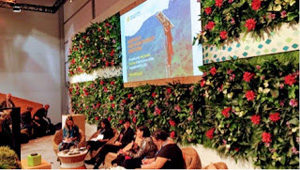
Behind Goal 13: Women Leading the Climate Agenda. Pay attention that instead of sitting on individual chairs the audience members are invited to share benches. This intentional design creates more intimate presence and a sense of human interdependence.
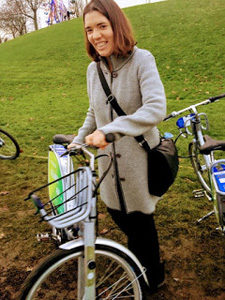
Katie—after we successfully managed to get our COP 23 bikes. I believe we were rushing to Bula zone to attend a press conference about International perspectives on German coal and European climate leadership.
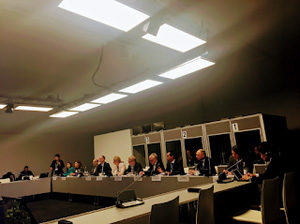
I attended a High-Level Dialogue where city mayors from Nicaragua, California, Poland and Japan talked about how their cities are implementing sustainable urban development goals, focusing on housing construction, cement industry and energy mixes.
Katie:
Gender Day at COP 23
Like Julia, I appreciated to opportunity to delve deeper into the interconnections of gender and climate change on COP 23 Gender Day. It was great to see so many events focusing on this critical issue. After the morning session in the Talanoa Pavilion about women leading the climate agenda I started to think more critically about the dynamics that I have seen so far at the conference. I started to realize how many events have been dominated by “manels” (as one speaker put it), focusing on the voices of men and often including only one or very few women. I was inspired by the women who spoke not only because of the amazing work they have done, but because of their willingness to criticize organizers of the conference and challenge them to do better. It was clear that we have to move from conceptualizing women as the first “victims” of climate change to thinking about women as the first leaders and innovators in climate change solutions. Women have the power, they simply must be enabled to exercise it.
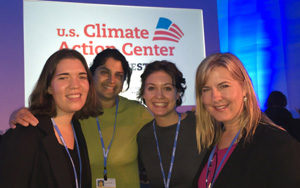
We closed out our day at the U.S. Climate Action Center – a pavilion funded by Michael Bloomberg after the U.S. federal government refused to fund a country pavilion leaving the U.S. without while many other countries such as Germany, France, U.K., Fiji, Thailand, Mali, Senegal, and many others showcased their efforts. We met and chatted with many other college students participating at this COP at the Higher Ed Reception. We also met up with fellow Minnesotans including Minnesota House of Representatives Minority Leader Melissa Hortman over dinner. It was a great way to connect with students across the country and within Minnesota about what they hope to learn from attending the COP and their perspective on climate action.
Julia note: People were wondering if Bloomberg himself showed up at the conference. A film-maker from the virtual reality (VR) pavilion told me that indeed Bloomberg showed up one day—briefly tried a VR headset and was rushed to a next event.
Day 10: Wednesday, November 15, 2017
Katie:
After spending the last two days navigating the conference halls I used my third day to go out and see the Energiewende in Germany in action as part of the Nord Rhein Westphalen Energie Agentur excursion program, like Ellie’s trip last week! I was especially intrigued to see German energy innovation in action after seeing many events the last two days on Germany’s ongoing fight to fully phase out coal by 2030. It was also nice to experience a change of pace from the chaotic environment of the COP.
I visited a pumped storage hydropower plant in the Sauerland, a rural and hilly region of the state. I heard from many different professionals about the context of the Energiewende, the advantages of pumped storage hydropower, and the specific technical workings of the plant. I found it particularly interesting to see a power company, who has shut down all coal plants but one (which will be closed next year) take on the challenge of the Energiewende so thoroughly. They seemed to be simultaneously ambitious and realistic; they envisioned a future where they could work to phase out all fossil fuels, yet maintained that for the time being natural gas was a critical part of their energy portfolio in order to supplement the fluctuating supply of energy created by wind or solar. We walked up to the reservoir, but the fog limited what we could see. The tour guides told us that on a clear day you could see all the way to Dortmund, about 100 km away!

We were treated to snacks, pumpkin soup and sandwiches for lunch, and a visit to the Bigge Skywalk. The skywalk is a scenic overlook on the Bigge Lake and dam, which were both created in the 1960s, forcing some local villages to relocate. Dams are yet another way this region is using hydropower to meet their renewable energy goals.
On the trip I got to meet more students from the States as well as an employee of the Energie Agentur for the state of Nord Rhein Westphalen who works on a project called Climate Smart Municipalities which connects Minnesota cities with cities in this region who have developed innovative sustainability projects in order to exchange ideas. We talked about the Minnesota Vikings, craft beer, and climate action on the local level. Minnesota connections really are everywhere!
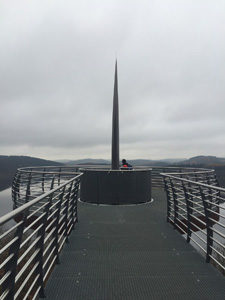
Things are starting to pick up at the COP. National leaders arrived at the conference today to give national statements at the inauguration of the high-level segment. German Chancellor Angela Merkel and French President Emmanuel Macron both gave speeches addressing the need to continue to work to implement the Paris Agreement. The Bula Zone in particular is starting to experience a flurry of excitement as negotiations start to wrap up and it will be clear what the results of this COP will be.
Angela Merkel and French President Emmanuel Macron both gave speeches addressing the need to continue to work to implement the Paris Agreement. The Bula Zone in particular is starting to experience a flurry of excitement as negotiations start to wrap up and it will be clear what the results of this COP will be.
Julia:
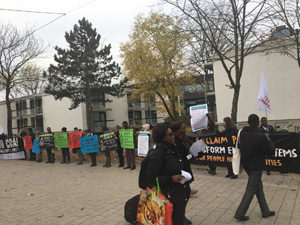
Photo: from the very early morning, protesters began gathering outside Bula (diplomatic zone), anticipating the arrival of state leaders, and demanding stronger statements, especially from Angela Merkel.
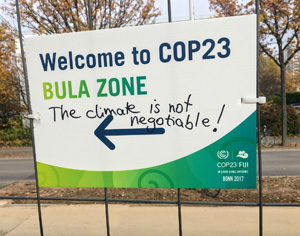
Photo: After attending several events about coal phasing out and financial instruments for climate action, I was headed back to watch webcast from the High-Level opening ceremony (where Merkel and Macron delivered their statements). This new comment appeared on the sign at the train platform.
Personally, I found both Merkel and Macron’s speeches too generic, especially in contrast to the language of the leaders from several Small Pacific Island states who I heard speaking more ambitiously and disruptively before. Merkel and Macron obviously made aspirational, abstract statement and reaffirmed their commitment to the Paris agreement. However, aside from Macron’s promise to top up the financing gap to the Green Fund created by the US withdrawal, I was not convinced that we should expect serious political climate actions from these states. Looking at how much needs to be done even at the EU level, I have a hard time imagining necessary steps taking place without major paradigm shifts.
Day 11: Thursday, November 16, 2017
Katie:
Today was Education Day at COP23! This meant that there were many events focusing on youth involvement in climate action and the interconnection between education and climate action. One of these events was the High Level Event on Climate Change Education that featured prominent speakers such as Executive Secretary of the UNFCCC Patricia Espinosa and Princess Lalla Hasna of Morocco. The event was probably the most theatrical one that I attended while at the COP. The room was the largest meeting room at the venue and was packed with people excitedly taking pictures and video of the Princess. The speeches were preceded by a performance from local children from Bonn singing about climate change. The event was more about bringing awareness to the critical role that integrating climate change into curriculum plays in climate action, and less about a critical discussion about current and future practices. It was similar to the COP Presidency events in which COP President and Prime Minister of Fiji Frank Bainimarama addresses the Bonn Zone along with other prominent speakers with a focus on a prominent issue. These events are intended to draw big crowds, be almost theatrical in nature, and raise awareness – in contrast to the more focused and technically oriented side events.
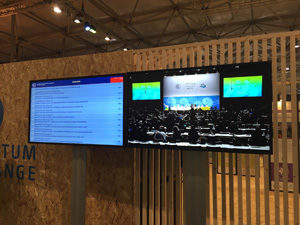

Today was also the last day of programming for the US Climate Action Pavilion and as I stopped by I collected some souvenirs and other free stuff (bags, lanyards, pins, and “We are still in” M&Ms!). It was fascinating to observe the U.S. presence at this COP. On the one hand the official delegation from the State Department was bare bones and played almost no role in the negotiations. On the other hand, you have what some have called the “alternative delegation” made up of local leaders, corporations, and other non-state actors taking up residence in the U.S. Climate Action Pavilion, declaring that the United States is “still in” for the Paris Agreement even if the federal government is not. I observed a fair amount of hostility towards the United States government in the different panels and discussions I attended, but experienced only friendliness and engagement as an American at the conference. It is clear that there are many leaders in the U.S. ready to step up and do their part for climate action, which is very encouraging, but I am also worried because while local leaders are leading on climate action, federal policy still does have a role to play. Overall, it is clear that the rest of the world is ready to move on without the U.S. – we will simply be left behind. As the rest of the world forms coalitions to power past coal and Germany experiences pressure the phase out their coal by 2030, Trump’s unreasonable grip on coal will prove to be backwards and regressive and will simply leave us lagging behind the rest of the world.
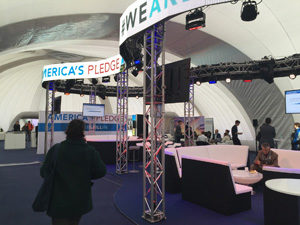
I also attended a side event detailing the current field of attribution science and the growing interest and practice of attributing climate change impacts to fossil fuel companies. The panel was made up of a climate scientist, environmental lawyer, and a lawyer/activist from Fiji. While this field is currently still developing, it seems to have a bright future and I will be following current lawsuits against fossil fuel companies closely in the next few years!
Julia:
While Katie shared her experiences with the education-themed events at the conference, I couldn’t stop rambling with overwhelming excitement and emotion about climate litigation panels that I had attended (we later discovered that we heard the same lawyer from Fiji who we both really appreciated, but I’ll talk about it later!)
I started my day with a cup of coffee and chocolate at the Nordic Pavilion where I heard from three women politicians from different Swedish parties about Sweden’s climate legislation, and particularly about their newest Climate Act. The Act comes into power on January 1, 2018 and sets binding obligations for the government to fulfill its climate targets. I found particularly interesting that the Act triggers the creation of an independent task force that will review government compliance with climate policy goals
every 4 years to ensure political continuity to climate agenda. I found Swedish legislative model really progressive since the speakers mentioned that the Act will help to harmonize all government ministries, institutions and budgets. Overall, the panel presented Sweden as a leader in climate change legislation and I think Swedish politicians aimed to channel the idea that all EU policies need to be made consistent with the Paris agreement, and that Sweden can spearhead that process.
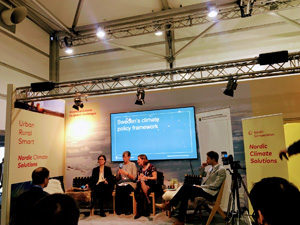
In the afternoon I attended three more side events on climate legislation that complemented one another really well. All the panels discussed the place of litigation and dispute arbitration in climate change response. As Katie said, this i field is just emerging so lawyers, activist and policy makers have a lot of enthusiasm but also a lot of questions and guesses about how to best move forward.
I enjoyed the presented from the Grantham Research Institute on Climate Change and Environment from the London School of Economics (LSE). They have a Climate Governance and Legislation Center which is currently developing a topology to determine what constitutes good climate governance. One of their speakers emphasized the need to look at both laws and policies since different countries may have different approaches to regulate climate action. They do both quantitative and qualitative studies, and I was impressed to learn that since 1997 to 2017, the number of climate laws increased from only 70 to 1400 laws! The laws, however, are disproportionately skewed towards legislation of the energy sector—so in the near future we can anticipate more legislation in other sectors like agriculture, forestry, etc.
While all events I attended discussed specifics of litigation, I appreciated that all of them also looked at legislation itself critically. Laws certainly create enforceable rules and accentuate responsibilities, however, institutions should also work together well to operationalize legislation. This resonated to me with the Swedish discussion in the morning about the Climate Act which seems to incorporate monitoring of institutional and ministerial harmonization to ensure successful application of the law.
Although many activists seem very enthusiastic about rights frameworks applied to climate issues, several panels also discussed limitations of law in achieving climate goals. I took the point that adjudication and litigation help clarify the law and mainstreams other issue areas such as women’s rights through land ownership that cumulative strengthen climate change resilience. On the other hand, negotiations are more cost-efficient under economic theory, but do not solve disputes. One speaker in particular emphasized that the Paris agreement will be in a constant state of re-negotiation due to the paradigm of national sovereignty (which means government changes will trigger different commitments to the Paris agreement). As we see, some states that agreed to the Paris provisions now disagree on some aspects, and vice versa, so negotiations will probably still remain key in driving climate action.
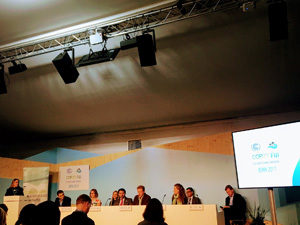
Photo: LSE event. You may see that many of the event pictures look generic—well, this is a standard set-up of side events in Bonn (Climate Action) zone. There were two types of events at Boon Zone: side events (often catered, 1.5-2 hr usually bringing different panelists together under a them), and pavilion events organized by the governments (these varied from country to country, so you can tell about national priorities from the events and tone in each pavilion. I attended an event at the Russian pavilion— and it was pure and shameless propaganda which was easy to tell if you are from the region.
Throughout the day I also have learned about many climate litigation cases, like the recent one in which a Peruvian farmer sued German energy company REW for contributing to climate change damages in his homeland. The court found the case admissible, and it will move forward. Another case to watch out for is People v Arctic Oil in which an Alliance of Greenpeace, youth activists and scientists sued Norway for the violation of the national contribution and the Paris agreement with a decision to open up Barents Sea oil exploration in 2016. Also a series of interesting cases are coming from the Pacific. Katie mentioned a woman lawyer/activist from Fiji who also spoke at one of my events. What fascinated me most was how the lawyer talked about the need to educate the community for a long time before filing the lawsuit. She mentioned that people in rural areas who are affected by climate change most do not see it as rights issue and often explain it through God’s will. She implied that education is necessary to ensure that people can give good testimonies that will help shape the case. This made me think about relational dynamics of different world views. I am particularly intrigues to see how we can deal with the interaction of cultures, norms, political and legal systems and entire worldviews in climate litigation since these cases often involve wealthier, post-industrialized states—polluters, and poorer states that are most affected. When this lawyer was making remarks about education, I read as “we need to indoctrinate people to think in the western notions of land, rights, ownership, individual, etc. to win these cases”—and I am not sure this is a good thing.
I really enjoyed Q&As in these sessions as they were more practical and specific, so I learned a ton. For example, someone asked about the possibility to put awards from court cases into a special fund to then cover climate financing gaps more efficiently, or the possibility to litigate against banks who finance fossil fuel companies. In fact, several attempts to hold banks as potentially liable are underway (i.e. banks funding Dakota Access Pipeline came under pressure from investors). Another fascinating case, is with Pennsylvania Pension Fund suing Exxon Mobile for climate deception!
My major takeaway was that both adjudication and litigation have a lot to offer, but should be advanced carefully so as to not damage negotiations. This sounds like a quite challenging task, as the pursuit of justice often requires non-compromise. But despite uncertainties, I am very energized by these talks and the potential of a new wave of climate litigation that can change both state and corporate responsibility for climate action.
Day 12: Friday, November 17, 2017
Katie:
Sadly, today is our last day at COP23! We arrived to an increasingly empty Bonn Zone as pavilions were wrapping up their programming for the week. It was a stark contrast to the chaotic excitement that we experienced earlier in the week. The day felt calm and subdued and lent itself well to some reflection on our week at the conference.
Experiencing a COP is unlike anything I could have imagined. It was exciting, inspiring, challenging, and exhausting all at once. The opportunity to immerse myself every day for a week in learning and discussing climate policy and action was instrumental in helping me gain a new understanding of where we stand and where we need to go as a global community. I was surprised at the amount of organizing that goes into such an event at this scale and the sheer expense of it all. At times the conference felt superfluous. Did we really need all that free coffee and chocolate? How many resources went into building a conference space that saw over 20,000 people pass through its walls? I’m still not sure how I feel about all the money and resources that surely must go into putting on such an event every year, but I do know that gathering together as a global community on climate change is a necessary and valuable endeavor. It encourages knowledge sharing, collaboration and enables the critical task of negotiating international agreements. Despite the fact that my experience at COP was so valuable to me personally and academically, I have concerns – and many of these concerns were discussed in our first event of the day in the German Pavilion on climate diplomacy in a post-Paris world.
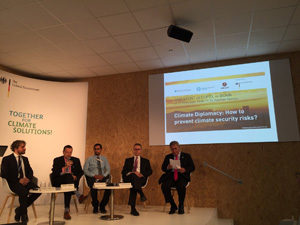
From L to R: Moderator, Ambassador Jumeau, Krishneil Narayan from Climate Action Network, Peter Fischer of the German Foreign Ministry, Prime Minister Sopoaga
This side event was one of the most impactful events I attended during my week at the COP. The panelists included the Prime Minister of Tuvalu, the UN Ambassador from the Seychelles, an official from the German foreign ministry, and the director of the Pacific Islands Climate Action Network. In some of the most passionate and engaging remarks I heard this week, Ambassador Jumeau criticized the climate “inaction” of the Bula zone, the lack of urgency of Western climate professionals, and the condescending treatment of island states, while advocating for a better integration of youth in climate action. This was followed by Prime Minister Sopoaga calling for action to help those most vulnerable to climate change – the Pacific Islands. They made clear that while the Pacific Islands are most vulnerable to climate change impacts, they are at the center of climate action – they are leaders, innovators, and pioneers and should not be viewed narrowly as victims (which is a role that some at this COP has subscribed to them). Ambassador Jumeau said, “We cannot afford for this to be an academic exercise”. He elaborated that he is not interested in seeing people getting doctoral degrees in human impacts from climate change – it is almost demeaning because people are really suffering and losing their livelihoods.
This event caused me to think more critically about how this COP was conducted – how was Fiji and fijian culture represented while holding the COP Presidency, whose voices were amplified and whose were not, and what role does/should academia play in the subject of climate change? While I have been skeptical about the efficacy of academic work to actually translate in helping people in areas such as climate change impacts, this discussion problematized the issue even further. I do believe that the work that we do at institutions like Macalester is important, but is not the most important when it comes to climate action.
This is something that I will continue to think critically about the rest of my time at Mac and into my future career.
